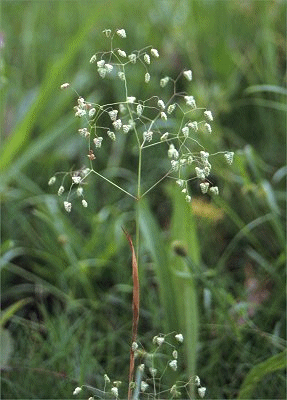Briza minor* Linn. Sp. Pl. 70 (1753).
Classification. (GPWG 2001) : Subfamily Pooideae.
Tribe Poeae.
Type of Basionym or
Protologue Information: CT: Anon., Habitat in Helvetia, Italia
(LINN-88.1). LT designated by Hubbard, Fl. Trop. E. Afr. Gram. 53
(1970); CT proposed by Jarvis, Taxon 41: 558 (1992).
Key references
(books and floras): [1878] G.Bentham, Flora Australiensis 7 (660),
[1952] C.A.Gardner, Flora of Western Australia 1 Gramineae (130),
[2002] D.Sharp & B.K.Simon, AusGrass, Grasses of Australia, [2002]
J.Wheeler, N.Marchant & M.Lewington, Flora of the South West (406), [2006]
J.Jessop, G.R.M.Dashorst, F.M.James, Grasses of South Australia (114),
[2008] S.W.L.Jacobs, R.D.B.Walley & D.J.B.Wheeler, Grasses of New South Wales
(172), [2009] A.Wilson (ed.). Flora of Australia, Vol 44A. Poaceae 2
(340).
Illustrations:
[1983] J.C.Tothill & J.B.Hacker, Grasses of Southern Queensland
(138), [1984] N.T.Burbidge. rev. S.W.L.Jacobs, Australian Grasses (79), [2006] J.Jessop, G.R.M.Dashorst,
F.M.James, Grasses of South Australia (116, fig. 75), [2008] S.W.L.Jacobs,
R.D.B.Whalley & D.J.B.Wheeler, Grasses of New South Wales, 4th edn
(172).
Habit. Annual.
Culms erect or decumbent, 7–60 cm tall. Mid-culm internodes solid. Ligule an
eciliate membrane, 3–6 mm long. Leaf-blades flat, 3–14 cm long, 2–9 mm wide.
Leaf-blade surface scaberulous or scabrous.
Inflorescence.
Inflorescence compound, a panicle. Panicle oblong or obovate, 4–20 cm long.
Spikelets.
Spikelets pedicelled. Fertile spikelets many flowered, with at least 2 fertile
florets (4–8), comprising 4–8 fertile floret(s), with diminished florets at the
apex, ovate or orbicular, laterally compressed, 2.5–5 mm long.
Glumes. Glumes
similar. Lower glume elliptic or orbicular or obovate, chartaceous, without
keels, 3–5 -nerved. Upper glume subulate or ovate, 2–5.5 mm long, chartaceous,
without keels, 3–5 -nerved.
Florets.
Fertile lemma 2–3 mm long, keeled, 7–9 -nerved. Lemma surface glabrous. Lemma
apex entire, muticous. Palea 2 -nerved. Lodicules present. Anthers 3. Grain
2.25 mm long.
Continental
Distribution: Europe, Africa, Temperate Asia, Tropical Asia, Australasia,
Pacific, North America, and South America.
Australian
Distribution: Western Australia, South Australia, Queensland, New South
Wales, Victoria, Tasmania, Norfolk I, Lord Howe.
Western Australia:
Carnarvon. Drummond, Dale, Menzies, Eyre, Avon. South Australia:
Flinders Ranges, Eyre Peninsula, Northern Lofty, Murray, Yorke Peninsula,
Southern Lofty, Kangaroo Island, South-eastern. Queensland: Darling
Downs, Moreton, South Kennedy, Wide Bay. New South Wales: North Coast,
Central Coast, South Coast, Southern Tablelands, North-Western Slopes,
Central-Western Slopes, South-Western Slopes, South-Western Plains. Victoria:
East Gippsland, Eastern Highlands, Gippsland Highlands, Gippsland Plain,
Grampians, Lowan Mallee, Midlands, Murray Mallee, Otway Plain, Otway Range,
Wilsons Promontory, Riverina, Snowfields, Volcanic Plain, Wannon, Wimmera. Tasmania:
Furneaux Group, North West, North East, Midlands, East Coast, South West.
Notes.
Introduced. Native to the Mediterranean and widely introduced into temperate
regions. A weed of disturbed areas often occurring with B. maxima.
Flowers Aug.-Dec.






